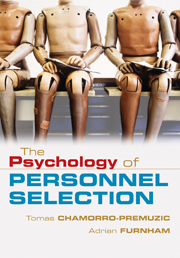8 - Creativity
from Part 2 - Constructs for personnel selection
Published online by Cambridge University Press: 05 June 2012
Summary
Introduction
Some employees are more creative than others: they are more likely to come up with original thoughts and novel solutions and stand out in organisations for their innovative thinking; they seem to prefer innovation to imitation and even enjoy defying the crowd. In this chapter, we discuss the key psychological factors underlying creativity and what personnel selection can do to select creative people.
Although the topic of creativity has a longstanding history in psychology (dating back to the very beginnings of intelligence testing more than one hundred years ago), creativity researchers have repeatedly complained about the fact that insufficient attention is given to the field (Guilford, 1950; Sternberg & Lubart, 1996). Indeed, despite growing economic interests and being associated with a wide range of concepts, such as intelligence (see Chapter 6), personality (see Chapter 7), leadership (see Chapter 9), imagination, motivation, social influence, intuition and talent (see Chapter 10) (Runco, 2004), creativity continues to be neglected from selection-related research.
In 1950, Guilford highlighted the importance of increasing creativity research after noting that only 186 of the 121,000 psychological studies in databases had dealt with creativity.
- Type
- Chapter
- Information
- The Psychology of Personnel Selection , pp. 175 - 190Publisher: Cambridge University PressPrint publication year: 2010

